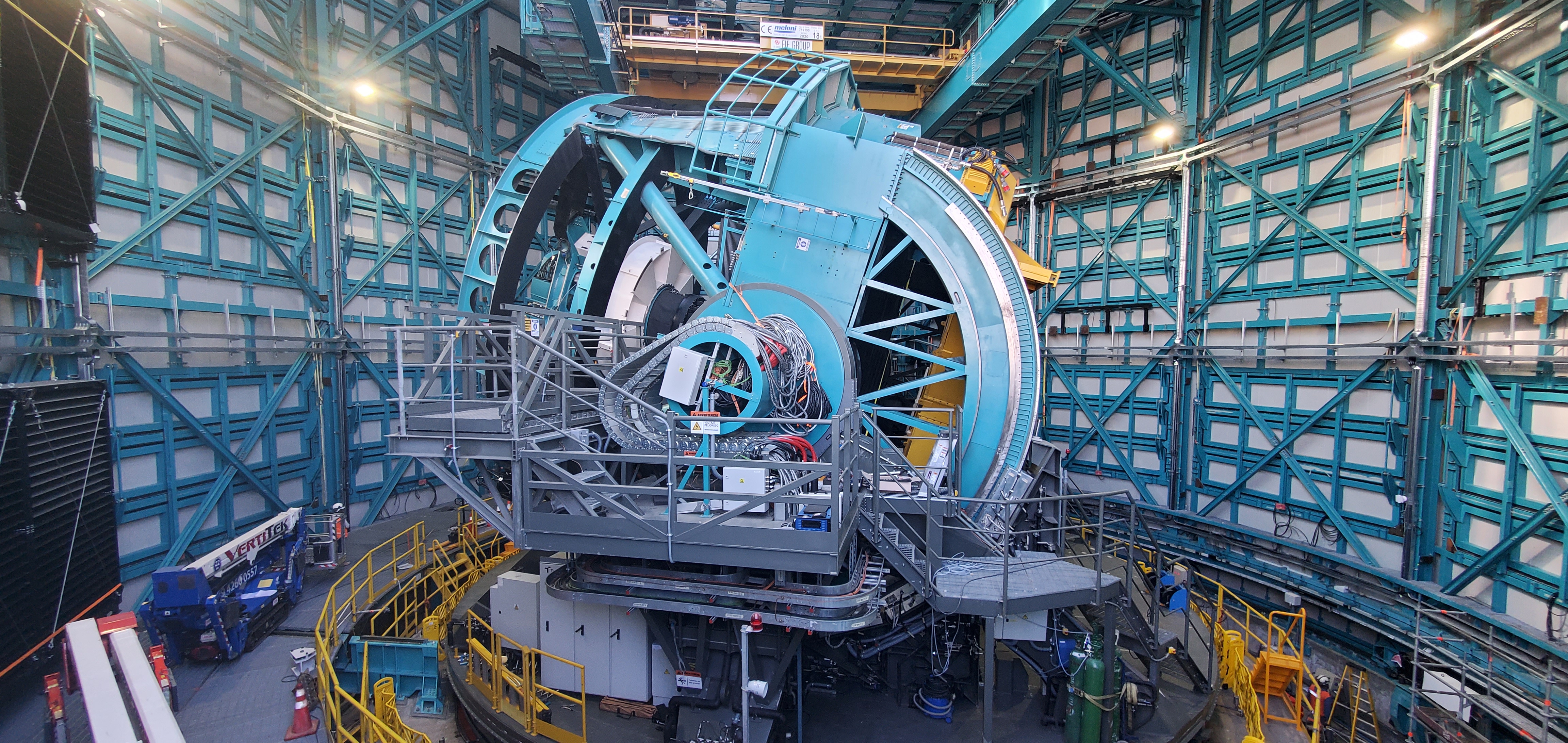The structure that will support the telescope’s optical system is handed over to the Rubin team
April 14, 2023 - Rubin Observatory celebrated a major construction milestone at the end of March, when the Telescope Mount Assembly (TMA), the structure that will soon support the observatory’s optical system, was declared substantially complete. That designation means that testing has proven that the TMA is functioning well enough for UTE, the Spain-based consortium contracted by Rubin to build and assemble the TMA on the summit, to hand it over to the Rubin team for integration of other components.
The TMA can be thought of as the “bones” of Rubin Observatory’s Simonyi Survey Telescope. This enormous structure will support the telescope’s mirrors and camera, moving them to point at different parts of the sky. The basic design of the TMA, referred to as an “altitude over azimuth mount,” has a lot in common with other telescopes, but it’s considerably shorter and has a lower center of gravity. This is so that the telescope can move from one area of the sky to the next very quickly and get ready to take another sharp, clear image after just a few seconds.
The TMA was fabricated, assembled, and tested at the UTE/Asturfeito factory in Spain over approximately two years and shipped to Chile as a 26-piece cargo shipment in August 2019. Once all the components of the TMA arrived on Cerro Pachón, the process of installing it in the summit facility began, and then had to be put on hold in March 2020 because of the COVID-19 pandemic. Even after Chile-based personnel were permitted to resume work on the summit in late 2020, international contractors faced travel restrictions and disruptions well into 2021. But once the Spanish team returned to the summit, activities resumed quickly, with the first successful manual rotation of the TMA on its hydrostatic bearings occurring in September 2021.
Next came the installation of the linear drive motors and utility systems, including miles of cables, piping, and hoses that provide electricity, communications, compressed air and coolants to the different parts of the telescope. To get onto the TMA these utility lines pass through multiple flexible “wraps” including a “spider spindle” on the top-end and an azimuth wrap at the center of the telescope pier. The azimuth wrap operates like a maypole: the cables wind around the central axis, moving up and down as the telescope rotates to keep the lines from getting tangled.
With the major hardware in place, the team’s focus turned to integrating and testing the control system (software) that drives the TMA. The control system was developed by a subcontracted company, Tekniker, who conducted an extended onsite visit to the summit, and continues to provide support remotely. Rubin is now setting up an extended support contract with Tekniker to ensure their ongoing help with refinement of controls, and any lingering or emergent issues that come up during commissioning and the lead-up to operations.
In recent months, Rubin’s team of observing specialists has been exercising the integrated hardware and software to test how accurately the TMA points and tracks, using two StarTracker cameras mounted on the outside of the top ring of the TMA. The observing team takes images of the sky with these cameras and uses astrometry software to determine where in the sky the telescope is pointing. The Rubin Systems Engineering team has been heavily involved in these and other test campaigns to ensure the TMA meets its technical requirements and is working as designed.
In the last two weeks of March, data from the StarTracker cameras, accelerometers and the Engineering and Facility Database were evaluated to verify that the mount performance met the required specifications. This campaign concluded with an end-to-end test of all critical TMA systems, resulting in the determination of substantial completion by UTE and turnover to Rubin.
Even with the completion of this auspicious milestone, UTE will continue to address a “punch list” of lingering issues and completion tasks over the coming weeks, leading to final acceptance and contract conclusion. Meanwhile, the Rubin summit team is preparing for the next major systems integration phase: installing the Primary/Tertiary mirror (M1M3) cell and surrogate mirror on the TMA.
Keep an eye on Rubin Observatory’s progress and other upcoming milestones here.


